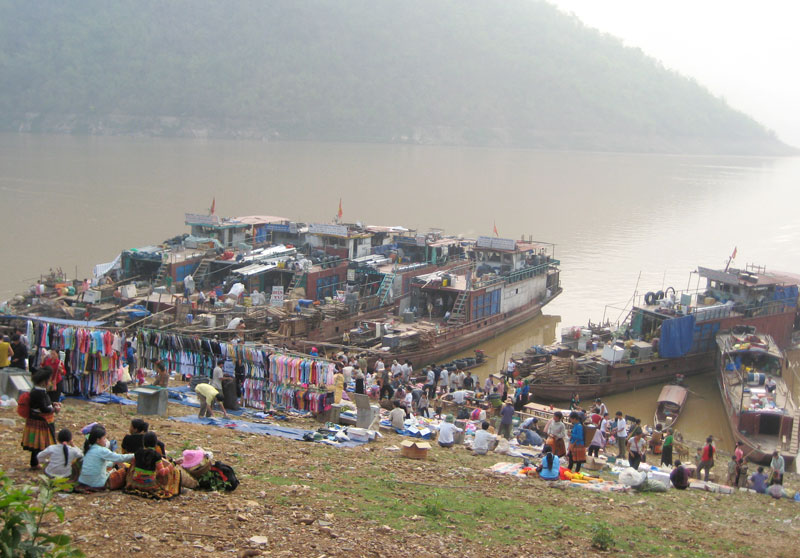
(HBO) – The Fair Market on Da River Lake is not only a place for trade and commodity purchasing between the lowland and the highland regions, but also the cultural and spiritual exchanges of river region. You can go to the market to buy a little tobacco, a little salt, sauce and also show your love emotion.
Due to the terrain characteristics, it is
more convenient to travel to the villages along the Da River by means of
waterways than travelling on roads; hence, there are many floating markets.
Almost every commune has a market place of the water wharf, boat harbor, where
ships and boats carry goods from down stream. This is also a place where the
local people sell their special products such as chicken, bamboo shoots, banana
pods, papaya, cassava roots, tubers self-grown, some forestry vegetables, fish
on the lake reservoir. There is every fair market in an approximate river
section of one or two communes and those regular markets are held every day in
turn in a month. The fair market of Tien Phong commune, on the road of Oi Noi
hamlet, along the river bank, is held three times a month, usually on the 10th,
20th and 30th of the month. Tra Ang fair market, in Vay Nua commune (Da Bac)
takes place on the 15th, 25th of the month. Hang Mieng Fair Market
in Quang Minh Commune, Van Ho (Son La Province) bordered on Suoi Nanh, Dong
Nghe (Da Bac) Communes open on the days of 1st, 2nd – 11th, 12th –
21st, 22nd.

The Fair Market is a very unique feature of
Hoa Binh Lake Reservoir. Photo: the fair market meeting in the area of Ngoi Hoa
commune, Tan Lac district.
The fair market areas are large yards close
to the lake or can be where the boats gather along the river. There is a small
bridge for people to see and purchase products. The market is always bustling
and crowded with buyers and sellers, on the habors and on the boats. The items
in the market on the lake are quite diversified. Traders come from many
provinces, most of which are Phu Tho, Son La, Bac Ninh, Hoa Binh, Hai Phong and
Nam Dinh. Traders of each province have their own special products, of which
mountain traders from Son La, Hoa Binh provide mainly brocading products, meat,
fish, agricultural and forestry products. Hai Phong, Bac Ninh, Phu Tho, Nam
Dinh supply mainly dried goods, clothes, shoes, electronic appliances.
A diverse chain of eco-tourism and resort destinations concentrated in Hoa Binh city and the districts of Tan Lac, Da Bac, and Luong Son… Along with the launch of several key high-quality resort tourism projects, these developments have reshaped the landscape and enhanced the appeal of Hoa Binh as a travel destination.
Boasting diverse terrain, a mild climate, and rich natural resources, Cao Phong district is increasingly asserting its place on Vietnam’s tourism map, attracting both domestic and foreign visitors. The district is renowned for its stunning landscapes, majestic mountains, a crystal-clear hydropower lake, and the unique cultural identity of local ethnic groups.
With its pristine landscapes, unique cultural heritage of Muong ethnic minority, and an expanding range of visitor experiences, Tan Lac district of Hoa Binh has fast become a captivating destination for both domestic and international tourists.
Until now, Sung village in Cao Son commune, Da Bac district remains the only Dao ethnic community in Hoa Binh province to develop a community-based tourism model. Beyond its untouched natural landscapes, cultural identity serves as the cornerstone attraction for visitors.
Alongside the diverse cultural identities of the Kinh, Muong, Tay, Thai, Dao, and Mong ethnic people, Hoa Binh province is also renowned as the "capital" of the northwestern Vietnamese cuisine, offering unique and distinctive dishes. At festivals, during Lunar New Year (Tet), or on significant family or community occasions, special dishes are prepared, leaving a lasting impression on visitors.
A Phong Linh (Yellow Tabebuia) flower garden in Thang village, Thach Yen commune, Cao Phong district is currently in full bloom, drawing a large number of visitors.



